REEL RETRO CINEMA: New looks at old flicks — and their comics connections…

By ROB KELLY
Is Conan the Barbarian a “comic book movie”? Considering that it’s rated R and features copious amounts of nudity and graphic violence, it’s clear the filmmakers didn’t think of it that way. But the 10-year-old me who saw the film with my slightly embarrassed Dad and older sister sure did. After all, Conan the Barbarian was a long-running Marvel Comics star!
Of course, Conan had been around since the 1930s, created by Robert E. Howard for the pulps before graduating to a series of novels that were still being published in the 1970s. Producer Edward R. Pressman spent a good chunk of that decade trying to acquire the rights, finally succeeding at the exact same time a bodybuilder named Arnold Schwarzenegger burst upon the scene. Even with that, Pressman still could not secure the proper financing, so he sold the rights to producer Dino DeLaurentiis, who never met a cinematic challenge he didn’t like.
DeLaurentiis kept Schwarzenegger and the script by Oliver Stone, hiring John Milius (The Wind and The Lion, Red Dawn) to direct. Milius brought on set designer Ron Cobb, who based the film’s look, at least partly, on the Conan paperback book covers by the legendary Frank Frazetta.
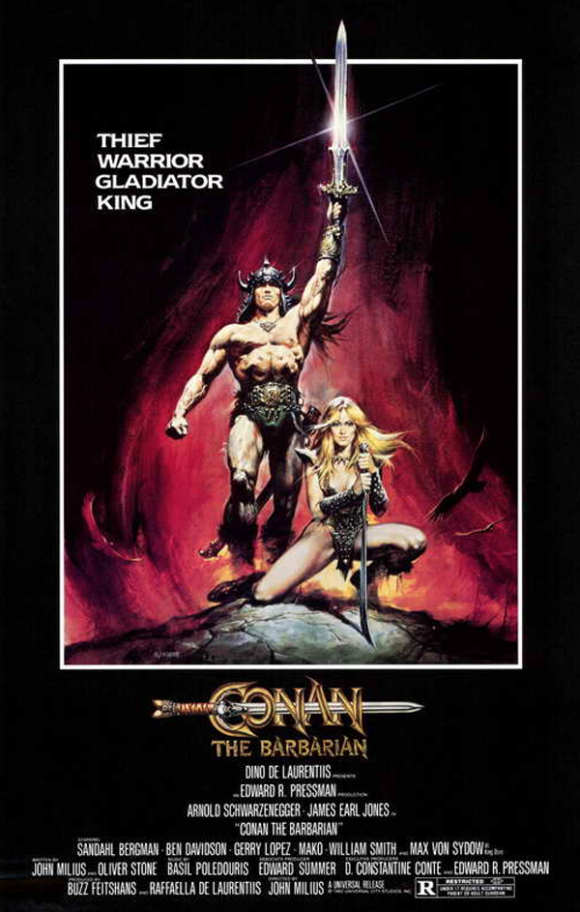
In the opening scenes of Conan the Barbarian — which was released 41 years ago this week on May 14, 1982 — Conan’s father is teaching him the importance of steel to his people, the Cimmerians. Not long after, the Cimmerians are slaughtered by the villainous Thulsa Doom (James Earl Jones), who spares only the children so they can be enslaved. Conan is strapped to the Wheel of Pain, eventually growing into the mountain of muscle we know him to be. He trains to be a gladiator and eventually wins his freedom, gaining an ancient sword that once belonged to the Cimmerian god Crom.
Conan has a one-night stand with a witch who delivers a prophecy to him, just before she turns demonic and tries to kill Conan, ending with him tossing her into a fire. He befriends a thief named Subotai and they head for the town of Zamora to find Thulsa Doom. On the way they meet Valeria (Sandahl Bergman), and together the three of them infiltrate a serpent cult, stealing some of their jewels. Later, they are captured and brought to King Osiric (Max Von Sydow, who previously worked for DeLaurentiis in 1980’s Flash Gordon), who asks them to rescue his daughter. She has become ensnared in Thulsa Doom’s cult, and Conan sees this as the proverbial killing two cult leaders with one sword—get revenge and make some coin in the process!
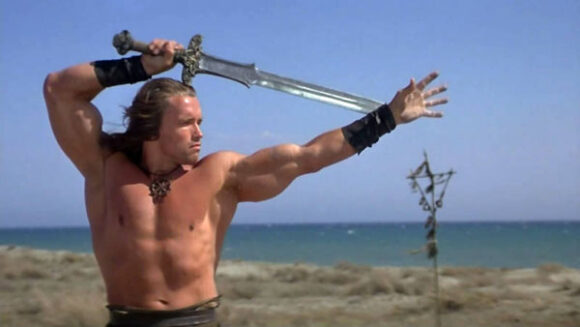
Valeria and Subotai refuse to go along, leaving Conan to do the job himself. He is captured and Thulsa Doom has Conan crucified on the Tree of Woe, which is pretty much what it sounds like. Conan almost dies, but is rescued by Subotai, who drags him to an old wizard named Akiro (legendary character actor Mako). Akiro brings Conan back to life, but warns that the spirits will exact a heavy price in the process. Valeria, who has rejoined the band, agrees to pay that price, literally fighting off the spirits that try to carry Conan off to the netherworld.
Now healed, Conan tries again to kill Doom but fails when the villain transforms into a giant snake and slithers away. As they depart, Valeria is struck by a magical arrow, fired by Doom, and dies. Preparing for one last battle, Conan begs Crom for divine help. This seems to come to pass when, just before Thulsa’s right hand man, Rexor, is about kill Conan, he is stopped by Valeria, who has become a Valkyrie. After losing all his men, Thulsa Doom tries to kill the princess, but Subotai stops him.
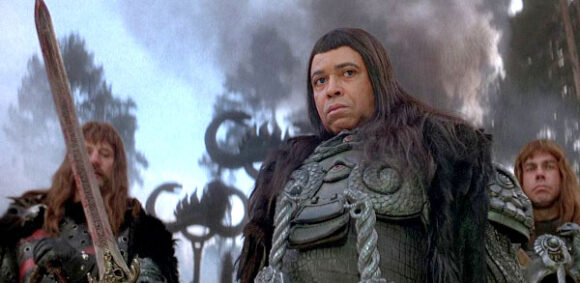
Later, while Doom is addressing his cult, Conan confronts him. Doom tries to hypnotize him, but fails, leading to Conan beheading Thulsa Doom and pitching his head into the crowd. The cult disperses, and Conan burns Doom’s temple down, returning the princess to King Osiric.
In an epilogue, Akiro (who has been narrating throughout) shows us an older Conan, who has, improbably, become a king.
As I mentioned at the top, at the time, my familiarity with Conan was entirely predicated on his status as a Marvel Comics star. He was so popular he headlined two titles, Conan The Barbarian and the black-and-white magazine Savage Sword of Conan, whose slightly more racy and/or bloody painted covers made procuring an issue feel like the kind of golden booty Conan himself was always after. So I don’t think my Dad was even aware that Conan The Barbarian was rated R and that it might not be appropriate for kids like myself.
Despite having seen thousands of movies in the meantime, I can still vividly remember my Dad looking uncomfortable during the scene where Conan meets the witch, with the two of them engaging in vigorous, relatively explicit sex immediately after. Indeed, Conan The Barbarian is a gleefully lusty, violent movie, giving our hero the chance to do stuff he only got to do in between the panels of his various Marvel Comics adventures.
In one of the greatest examples of Right Place, Right Time in Hollywood history, the delay in getting the rights to make a Conan movie dovetailed perfectly with the emergence of Arnold Schwarzenegger. Turned down for numerous Hollywood action roles because of his accent, Schwarzenegger had the perfect “otherness” for the role of a barbarian from the Hyborian Age, a time where magic and monsters are commonplace. No Hollywood actor would have been truly believable in the role; they would have been too familiar, too American. But Schwarzenegger, with his unusual accent and nearly unbelievable physique, was the perfect choice.
His director, John Milius, who keeps Conan’s dialogue to a minimum, helps him innumerably. When he finally does talk (about 25 minutes into the film), Schwarzenegger is given one of the best introductory lines in movie history. Responding to the question, “What is the best in life?,” Conan responds with the brutal, yet kind of pithy, “To crush your enemies, see them driven before you, and to hear the lamentation of their women.”
One of the film’s nicest touches was the casting of movie tough guy William Smith as Conan’s father. Smith was exactly the kind of actor that you could imagine playing Conan if Hollywood had tried to make the film in the early ’70s. By 1982, the audience was ready for a change in the types of action stars it wanted to see, and Smith metaphorically handing the reins to Schwarzenegger represents that change.
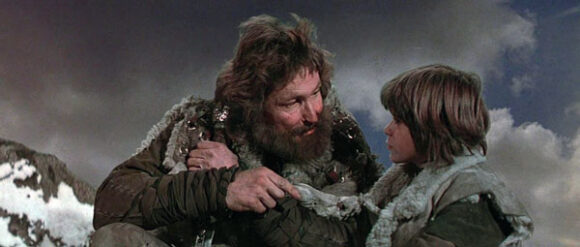
For me, one of the most interesting aspects of writing the REEL RETRO CINEMA column is when a comic book property gets adapted into a movie, only to get adapted back into a comic book. Do the creators of the adaptation try and make a comic book version of the film, or do they skip the middleman and just make the kind of comic book that started it all in the first place? In the case of Conan The Barbarian, we have two examples to consider.
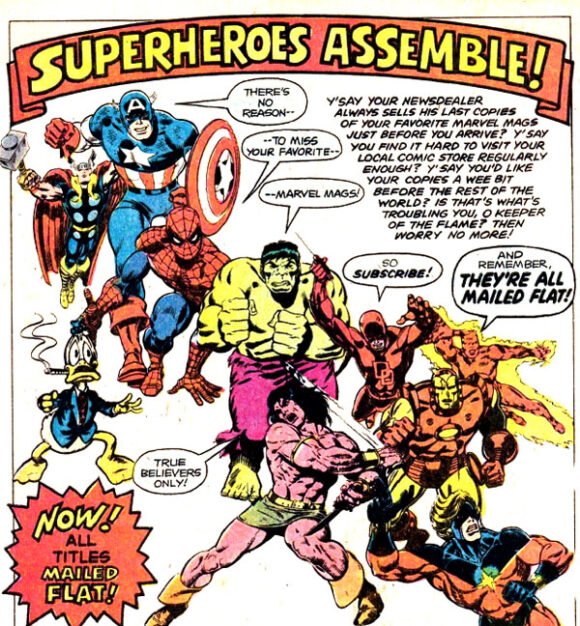
Naturally, Marvel Comics had dibs on the movie adaptation, since they owned the rights to Conan and he was one of their most popular characters (despite not being part of the Marvel Universe, he was a staple in their marketing—merchandise, subscription ads, etc.—appearing alongside Spider-Man, the Hulk, Thor, and the rest). Instead of adapting the movie within the pages of their regular Conan the Barbarian title, or even Savage Sword, where the film’s R rated thrills could have been more directly realized, Marvel decided to run it in Marvel Super Special #21, written by Michael Fleisher and drawn by longtime Conan artist John Buscema.
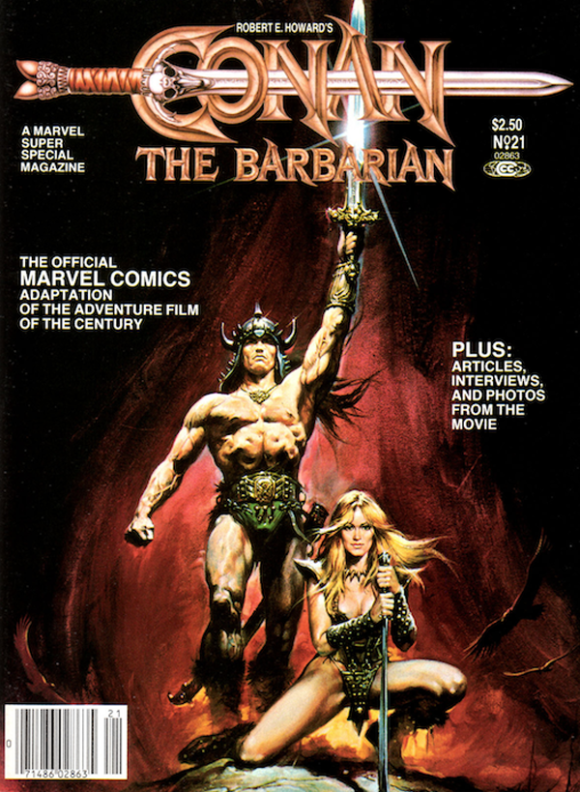
Fleisher and Buscema ended up taking the “let’s just make a Conan comic” approach—not that there’s a single thing wrong with that. Other than a more painterly approach to the coloring (par for the course for Marvel Super Special), “Conan The Illustrated Story” reads like a long form Marvel-style Conan adventure. Buscema doesn’t attempt to make Conan look like Schwarzenegger, nor do any of the other characters look like the actors from the film. The graphic violence is tamped down a bit; as is the sex and nudity, and this Conan talks more than he does in the movie. There are feature articles on Milius, Schwarzenegger, and James Earl Jones, but also one on Ron Cobb, underscoring how important his production design was to the success of the film.
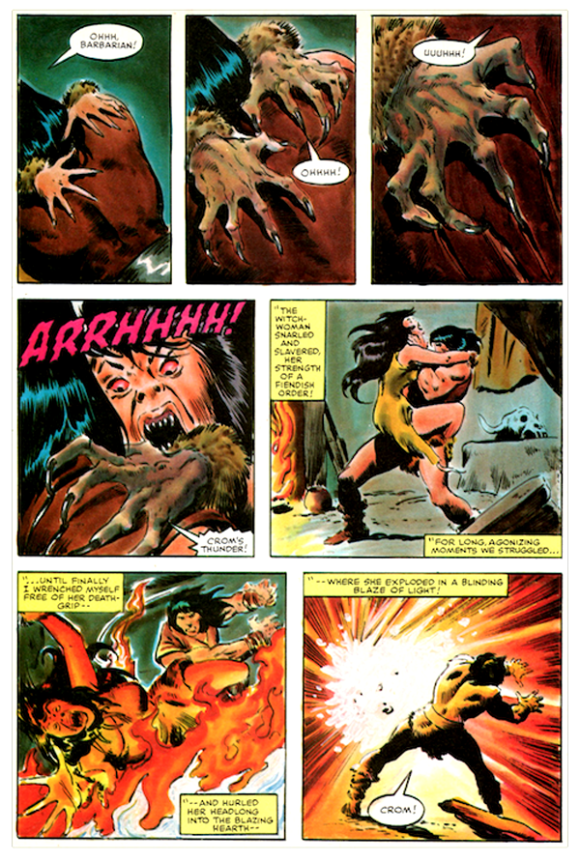
The adaptation was repurposed as a two-issue mini-series, Conan The Barbarian Movie Special, featuring Buscema’s version of the movie poster on the first issue’s cover (with Subotai added), and a brand-new piece for the second. Why this wasn’t run in the regular Conan The Barbarian series (or that year’s Annual, published around the same time) is a mystery only Crom, or maybe editor Louise Simonson, can answer.
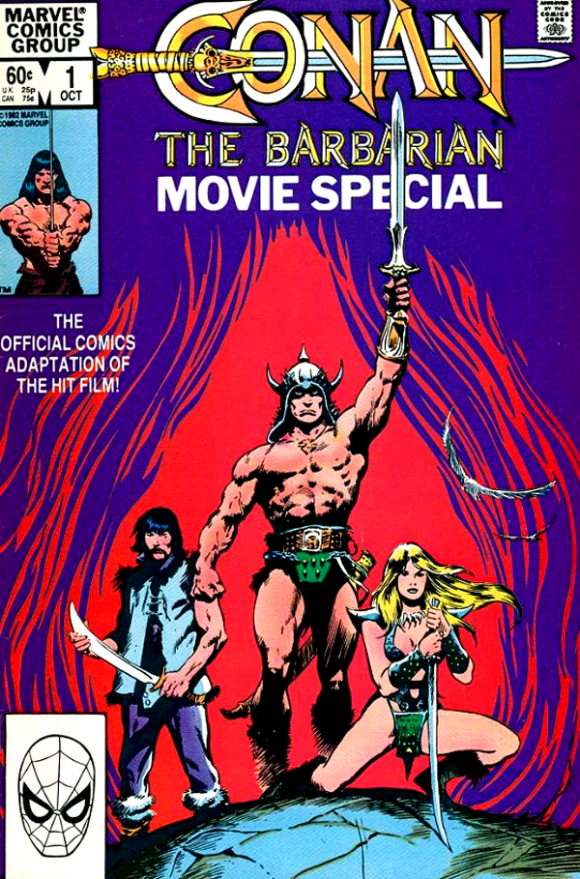
Another take on the movie can be found on vinyl, thanks to Peter Pan Records, which released their version on an LP that same year. The Conan audio adventures from the 1970s are some of the label’s best work, and they were among my favorite Power Records (Peter Pan’s comics-centric sub-label) as a kid. I never even knew they released a movie-themed LP until just a few years ago, when I discovered it on eBay (I bought it about five minutes later).
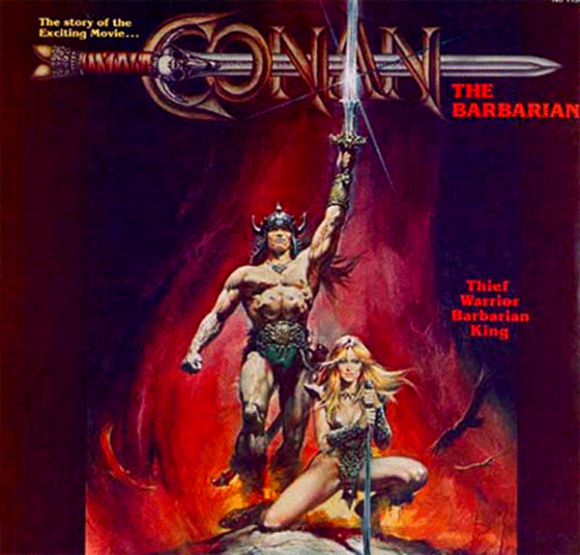
Not only does Conan narrate his own story, but this version features characters and scenes that don’t happen in the movie; perhaps they were working from an older version of the script (when director Milius took over, he rewrote Oliver Stone’s treatment). It reminded me a bit of those radio productions Hollywood used to do in the 1940s, when they would adapt feature films with some of the original cast, but in truncated form. Unsurprisingly, the sex and violence is almost entirely eliminated (for example, Conan neither sleeps with nor kills the witch that takes him in). It’s not quite as much fun as their 1970s efforts, but I’m glad it exists, especially since by 1982 Peter Pan was on its last legs, having mostly stopped producing original content featuring the various Marvel and DC characters they had the rights to.
Conan The Barbarian was a success at the box office, becoming the 13th highest grossing film of the year. It was an even bigger success on home video, and it turned Arnold Schwarzengger, improbably, into a movie star. As anyone alive during that time remembers, he dominated the 1980s movie scene, becoming one of the biggest leading men of all time. He would play Conan again in 1984’s Conan The Destroyer, and kinda sorta played a version of the character in 1985’s Red Sonja. Neither one of those films can hold a magic snake to the original, which, even 40-plus years later, delivers the goods for anyone looking for a big, bold, adventure fantasy epic. If you’re a Conan fan like I am, it is truly what is best in life.
—
MORE
— Dig This INSIDE LOOK at the 1977 SPIDER-MAN TV Pilot. Click here.
— ROY THOMAS Pens New Prelude to 1970’s CONAN THE BARBARIAN #1. Click here.
—
Rob Kelly is a podcaster, writer, and illustrator. He is the host of various shows on the The Fire and Water Podcast Network, including Fade Out, Pod Dylan, TreasuryCast, and M*A*S*HCast.

May 21, 2023
The 1982 “Conan the Barbarian” movie is an awesome one in and of itself.